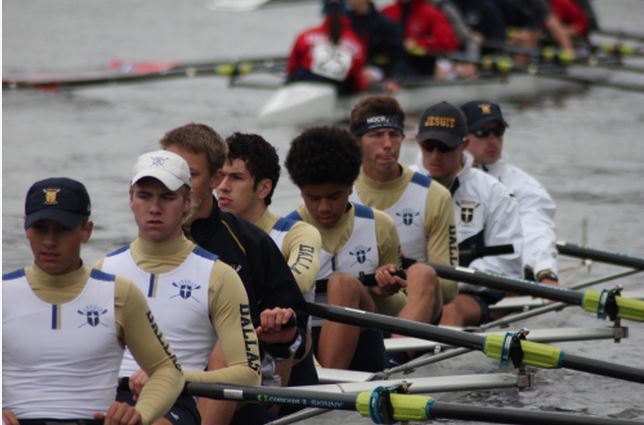Crew is a team-oriented sport, in which all of the members of a boat have equally important roles in winning a race. While the sport may seem as simple as athletes just rowing a boat down a river, there is a man behind the scenes who is a vital component to the whole of the boat, the coxswain.
The coxswain has two essential roles. His first role is to steer the boat with a rudder that he controls from his seat. Essentially, the coxswain tries his best to steer the boat in a straight course to complete the course in the shortest distance possible. The coxswain’s second role is to be the on-board coach and play caller. He is given a microphone which is connected to speakers throughout the boat so that all of the rowers can hear the strategy and receive constant motivation throughout the race. Head Coach of the Jesuit crew team John Fife puts it simply, saying, “The coxswain needs to be small (under 120 pounds) in stature as to not weigh down the boat, but big in personality and drive.”
Because of these two essential roles the coxswain has, he is extremely critical to the team’s success. He motivates the team whether in practice or an actual race. Personally, Fife feels as though he relies “on the coxswains to relay what I am trying to teach to the guys in the boat. I rely on the constant feedback from the coxswain to help me determine the best strategies, lineups, and calls. The coxswains help me and the coaches with getting the actual boat ready for practices and races.” Ultimately, the coxswain performs the tasks centered on strategy and mentality while the rowers use the fuel provided by the coxswains to row to their full potential.
In talking about his own experience with coxswains, Fife explains, “The coxswains have played a role in all our wins. However, they don’t always get the accolades like the rowers. The fact of the matter is, it is really easy to be a bad coxswain. A bad coxswain could really mess up a race plan and could easily cost a boat a victory. We are lucky to have coxswains we can rely on to not only ‘not mess up,’ but also be an integral part of the successes. A lot of times during a race, our original plan may not be working out and the coxswain has to make the call to change the plan. Coaches are not allowed to coach from the shore during a race, so it’s up to the coxswain to make the call.”
The current varsity coxswain for the Jesuit crew team is Elliot Stone ’15, who has been the varsity coxswain for 2 years now. Not only does he cox the varsity 8, he also mentors the other coxswains (Chris Bibanco ‘16, Parker Allen ‘17, James French ‘18, and Carter Elliot ‘18) on how to follow the Jesuit strategy for the races. Fife continues “I expect all of our coxswains to play a positive role in helping our rowers and crews be successful both on and off the water. We have the same expectation of our coxswains as we do our rowers- hard work and commitment.”
Stone personally describes his position as coxswain as “the responsibility type role in the boat,” where it is his “job to make sure everyone’s technique is in check and to make sure that they are depleting themselves from stroke one to the end of the workout or race.”
Overall, the coxswain is equally as important as each of the rowers in the boat, because he is the primary factor from which the rowers are able to gain motivation and instruction. Only when the coxswain is performing efficiently can the rest of the rowers perform efficiently and carry the whole team to victory.
Check out this video about the Jesuit crew team in a race at the National Championships from former coxswain Ryan Terry’s ’13 perspective:






